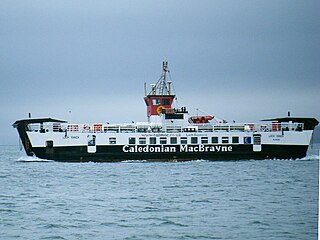
MV Caledonian Isles is one of the largest ships owned by Caledonian Maritime Assets Limited. She is operated by Caledonian MacBrayne (CalMac), which runs ferries to the Hebridean and Clyde Islands of Scotland. Caledonian Isles serves the Isle of Arran on the Ardrossan to Brodick route. As it is one of CalMac's busiest routes, Caledonian Isles has the largest passenger capacity in the fleet, and can carry up to 1000 passengers and 110 cars, with a crossing time of 55 minutes. She is used extensively by day-trippers to the Isle of Arran during the summer.

MV Isle of Lewis is a Scottish ro-ro ferry, owned by Caledonian Maritime Assets Limited, and operated by Caledonian MacBrayne between Oban and Castlebay, Barra. Built in 1995, she remains one of only two ships in the CalMac fleet over 100 metres (328 ft) in length; the other, Loch Seaforth, being longer by almost 15 metres.

The Caledonian MacBrayne fleet is the largest fleet of car and passenger ferries in the United Kingdom, with 34 units in operation and another 2 under construction. The company provides lifeline services to 23 islands off the west coast of Scotland, as well as operating routes in the Firth of Clyde.

MV Hebrides is a ferry owned by Caledonian Maritime Assets Limited and operated by Caledonian MacBrayne from Uig to Lochmaddy and Tarbert, the main settlements of North Uist and Harris respectively.

MV Hebridean Isles is a ro-ro vehicle ferry owned by Caledonian Maritime Assets Limited and operated by Caledonian MacBrayne on the west coast of Scotland. She was the first MacBrayne vessel to be built outside Scotland and the first to be launched sideways. With bow, stern and side ramps, Hebridean Isles is suitable for all the routes served by the large fleet units. After 15 years crossing the Little Minch on the Uig triangle, she now serves Islay.

MV Isle of Arran is a drive-through ferry owned by Caledonian Maritime Assets Limited and operated on the west coast of Scotland by Caledonian MacBrayne. Built in 1983, she served on the Arran service for ten years before being moved to Kennacraig. She returned to her original route in 2012, supplementing MV Caledonian Isles in summer and becoming a relief vessel in winter. In 2013, she started a new pilot route from Ardrossan to Campbeltown, which became a permanent fixture in 2015.

West Loch Tarbert, Argyll is a long and narrow sea loch on the western side of the Kintyre peninsula in Scotland.

MV Canna is a car ferry built for Caledonian MacBrayne (CalMac) in 1975. She spent 21 years in various locations on the west of Scotland and 20 years at Rathlin Island, Northern Island, before moving to Arranmore.

MV Loch Bhrusda is a Caledonian Maritime Assets Limited water-jet propulsion ro-ro car ferry operated by Caledonian MacBrayne. After 11 years operating in the Outer Hebrides, she is now a Clyde-based relief small vessel.

MV Loch Ranza is a Caledonian Maritime Assets Limited ro-ro car ferry, operated by Caledonian MacBrayne, serving the island of Gigha.

MV Loch Dunvegan is a Caledonian Maritime Assets Limited car ferry built for the Isle of Skye crossing and now operating in the Kyles of Bute, Scotland. She is operated by Caledonian MacBrayne.

MV Loch Alainn is a Caledonian Maritime Assets Limited ferry built in 1997 and operated by Caledonian MacBrayne. Berthing problems on her intended route at Fishnish meant she began a decade of service at Largs. Since 2007, she has operated across the Sound of Barra.

MV Loch Striven is a Caledonian Maritime Assets Limited ro-ro car ferry, built in 1986 and operated by Caledonian MacBrayne. After over ten years at Largs, she spent 16 years on the Raasay crossing. Since 2014, she has been stationed on the Oban - Lismore crossing.

MV Loch Linnhe is a Caledonian Maritime Assets Limited ro-ro car ferry, built in 1986 and operated by Caledonian MacBrayne After over ten years at Largs, she was the summer vessel on the Tobermory–Kilchoan crossing from 1999 to 2017.

MV Isle of Cumbrae is a Caledonian Maritime Assets Limited ro-ro car ferry, built in 1976 and operated by Caledonian MacBrayne. For ten years she was at Largs and operated the Loch Fyne crossing from 1999 to 2014. She was replaced by the MV Lochinvar in 2014, a new diesel-electric hybrid ferry capable of holding 23 cars and 150 passengers. She returned to Tarbert in 2016 after MV Lochinvar was moved to the Mallaig - Armadale station. She is now the oldest vessel in the Calmac fleet.

MV Loch Tarbert is a Caledonian Maritime Assets Limited ro-ro car ferry, built in 1992 and currently operated by Caledonian MacBrayne. She has spent most of her career on the seasonal Claonaig – Lochranza crossing.
MV Cowal was a hoist-loading vehicle ferry introduced by Caledonian Steam Packet Company in 1954. She spent the whole of her 24 years with Caledonian MacBrayne on the Upper Clyde crossings.

Caledonian Maritime Assets Limited owns the ferries, ports, harbours and infrastructure for the ferry services serving the west coast of Scotland, the Firth of Clyde and the Northern Isles.

MV Clew Bay Queen is a car ferry at Clare Island. Built in 1972 as MV Kilbrannan for Caledonian MacBrayne, she operated mainly at Scalpay, Outer Hebrides until 1992. As Arainn Mhor, she then operated the Arranmore ferry in County Donegal.

MV Catriona is a pioneering diesel electric hybrid passenger and vehicle roll-on, roll-off ferry built for Caledonian MacBrayne for the Claonaig–Lochranza crossing. She is the third hybrid ferry commissioned and owned by Caledonian Maritime Assets, one of three such ferries in the world to incorporate a low-carbon hybrid system of diesel electric and lithium ion battery power. The ferries are sea-going and are nearly 46 metres (150 ft) long, accommodating 150 passengers, 23 cars or two HGVs.



















